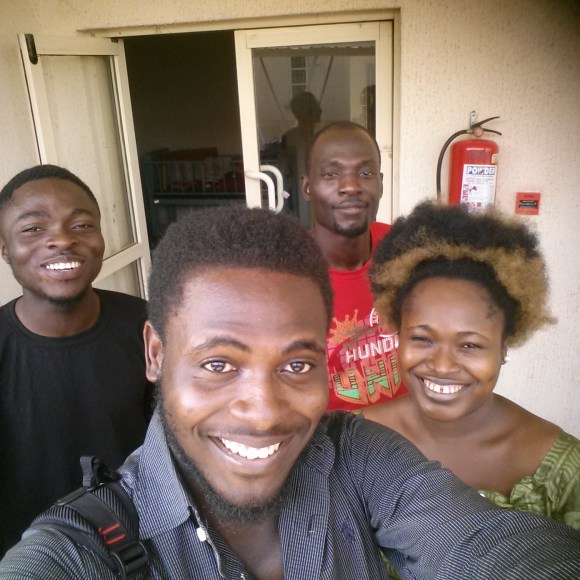
The cinema of Nigeria, known by its nickname “Nollywood,” has a rich and varied history. In fact, today it’s one of the largest of its type in the entire world.
And yet there was a time when you’d have been hard pressed if trying to learn about it on the English Wikipedia.
That’s where volunteer Wikipedia editor Sam Oyeyele, known on the site by the moniker “Jamie Tubers,” stepped in. “Before I started editing Wikipedia, I was able to find most, if not all, of the information I needed on films from the US, UK, India, and others on Wikipedia,” he told me. “This wasn’t the case with Nigerian films.”
This state of affairs did not sit well with Oyeyele. For him, Nigerian cinema is something that “I have been in touch with since my childhood … It’s only natural for me to be drawn to it.” An avid film watcher, he says that the best film he’s seen recently is Isoken, a 2017 Nigerian romantic comedy that focuses on the familial pressure to marry once hitting a certain age.
Starting in 2011, Oyeyele began writing articles on Nigerian films; by 2015, he produced an entire series of articles about the country’s cinema history. This is one way Wikipedia works: one or more people with drive, dedication, and a passion for a specific topic donate their time towards the “free encyclopedia” with the end goal of giving everyone the sum of all knowledge.
(“Free” does not just refer to the cost. All text on Wikipedia is copyrighted under the free Creative Commons BY-SA license, meaning that anyone can re-use the work as long as they attribute the writers of the article, available at each article’s history page, and share it under the same license.)

Oyeyele’s articles have divided the history of Nigerian cinema into four parts, though there is some overlap between them: the Colonial era, ranging from the late nineteenth century into the 1960s; the Golden Age, from the 1950s to 1980s; the Video film era, from the 1980s to 2010s, and the still-emerging New Nigerian cinema.
It is that last era that interests Oyeyele the most. “Nigerian cinema is quite interesting at the present time,” he writes, due to its “relatively fast-paced technical development, industry re-structuring, and a rush in investments.” While elements of New Nigerian cinema emerged in the mid-2000s, news sources have pinpointed the 2009 film The Figurine as its harbinger. The supernatural thriller did not make back its budget at the box office, but received acclaim both within Nigeria and in international film circles.
“At the time when The Figurine was released in 2009, audiences were getting really tired,” Oyeyele writes:
Film quality had stagnated, and the stories had been watered-down. People wanted more … Then The Figurine came and was perfectly suited to satisfying that thirst. After its release, the industry was transformed, and even better films have since been released. The Figurine is often referenced as the “revolutionary film” which led to the growth and development that the industry is enjoying once again.
Outside these big-picture articles, Oyeyele has written or helped write dozens of articles on Nigerian cinema. This includes the psychological horror October 1, where a police officer is sent to investigate and solve a string of murders before Nigeria’s Independence Day.
Doing this hasn’t been easy, especially for films that were released more than a decade ago, before the emergence of New Nigerian cinema. Many Nigerian news outlets do not maintain archives, which leads to a significant amount of lost knowledge and a much more time-consuming process for Oyeyele.
He usually resorts to doing research in physical paper sources, which are much better maintained; of the digitized news and research papers that remain, “they usually don’t top the search engines. You have to go through double-digit pages [of search results] before you can find usable sources.”

Over the years, Oyeyele has also gotten involved in community outreach in Nigeria, which included becoming an active member of the Wikimedia user group in Nigeria. His upcoming plans, which are already in motion, include branching into community-building activities, especially with the Nigerian user group’s new hub in Ilorin, the sixth-largest city in the country. Through those entities, he recently helped organize an international photographic competition, and is hoping to continue ramping up his work.
“I just feel that although it’s cool that I’m creating all these articles and contributing this much, I can’t do it alone,” he writes. “Wikipedia’s content gaps would be closed much faster if I can get more Nigerians to do the same things I do—we’d get many more topics and interest areas covered.”
Still, his expanded participation in those areas does not mean he’s stopped writing. There will always be more Nigerian films that need to be covered on Wikipedia. Like, say, expanding the article about The Wedding Party.
Ed Erhart, Senior Editorial Associate, Communications
Wikimedia Foundation

Can you help us translate this article?
In order for this article to reach as many people as possible we would like your help. Can you translate this article to get the message out?
Start translation